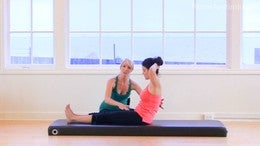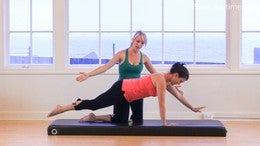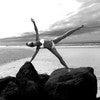Description
About This Video
Transcript
Read Full Transcript
Hi, I'm Michael King and I'm here today to talk about pregnancy. First of all, congratulations if you are pregnant and you just had some news I want to day to give you some advice on if you're taking class here on plaza anytime or if you're going to another group class. If you are looking at to begin to some personal training, then hopefully the instructor will give you some modifications and some changes that are needed to go through, but really some good information that you should know is if you've been exercising already, then you should be okay to continue with exercise. If you've not been exercised and you just had the news, I would before you start any class, get the okay from your doctor that it's okay to start exercise the first trimester, the first period of the pregnancy, you're probably going to be able to do pretty much what you've been doing. If you've been doing in class, it's really from about week 16 that you're going to have to start changing a lot of the movements, specifically the movements on your back. These are movements, which at that point the weight and the pressure of the baby could affect how much oxygen is going to go to the heart and could ultimately affect the baby. Now usually use my start feeling dizzy and as signs that this is happening, but really they could have been some damage done already to the baby.
So we want to make sure that we change things quite a at that period. Quite specifically. The other thing we need to consider is really as the increase in Burgers is the increasing the directors is going to be splitting. So we want to avoid any exercises which are really training the directors. So we're going to be looking at some movements today and just seeing how we can change the movement. How are you and adapt the movement, hopefully keeping the same focus in it.
We'll talk a little bit later about post-pregnancy, especially the postpartum period just after the pregnancy. But when I started going through some of the movements, I've got Christie today here helping me. She's not pregnant, but we're gonna start showing you some of the modifications and some of the changes that you should do during the exercise. So the first thing we're gonna start with today is the roll up. Now, just to show you the traditional movement for the drizzle movement starts from a supine position flat down with the arms behind you. As you lift the arms up, we're going to slowly breathe out, roll forward, keeping the curl, let them forward over the legs, stretching out, and then slowly rolling back down. So this is the roll up movement. So really from about week 16 they saved the guidelines, say 16 for most of my clients, it can be a little bit sooner.
We say normally from about week 12 is that really you should avoid working that rectors. So what w in this particular movement, what I'm gonna ask you to do is go ahead and sit up, bend the knees, and we're gonna start from a sitting position. From here, we're going to place your hands behind your legs from lifted up and all we're going to do is take a small movement back curve. In the spine, back, rolling back, keeping contact with your hands, taking your breath in and as you breathe out, roll back up and come back up to a city position. Again, breathing in, breathing out as you roll back. So hands are supporting the weight of the body and here you're not involving the rectors in the movement. You're getting the support from the hands breathing in and breathing out. So really what we've done is we've switched the purpose here with this modification instead of it being for a strength movement, we really using the Movement for mobility for the lumber spine and it's really in that last period of the pregnancy you're going to feel a lot of tension and this should helpfully relieve a lot of that tension in the lumbar spine. Let's just take one more of these now remember, as your pregnancy increases, you're going to feel you're going to want to reduce the range of movement to keep it very small.
So really if you feel any work in the lumbar or even the lumber getting close to the mat, you've gone too far. You want to really feel that their hands is doing most of the work and not directors taking it back and then coming back up using it just for mobility of the lumbar spine. Just working right here in the lumber. One more time rolling and then coming back up into a sitting position. The next movement we really look at is the one leg circle for me and normally traditionally it was done in supine position and it was done with the legs either bent over the leg straight. Now this is the one of the movements again that you're laying on your back.
So really from week 16 or 12 to 16 you want to start finding another alternative instead of the circle in the leg on the back. With this movement, you're focusing not just on the mobility at the stability of the pelvis, but also the mobility of the hip. So what we can do is we can change the position you're laying in and go to a sideline position. Now from here, extend the arm out. Then the underneath leg up. And specifically if you've got a towel, as you progress with the pregnancy, a talent and neath is going to help give a little bit of support for the baby. We're going to lift the leg up here and keeping the length of the leg. We're going to make the circle.
Now we're going to try and make the circle as big as you can without moving the pelvis. So we're going to keep this stability of the pelvis. Just be aware that you're not tenting the shoulder and use one breath out and breathing in to make sure that circle is complete. So breathing in and breathing out for one circle. Now you could just do around five, change over to the other side on five, then come back to come to the first site and do five in the opposite direction. So rather than doing a lot of repetitions in the same position, you're giving that hip a little bit more release.
Remember we AV as soon as you find out you're pregnant, then what happens with um, the stability of that joint with the hormone relaxing is increased. This is a hormone we have inside of our body, but of course it severely increases and so your stability in that joint is not that great until really you stopped breastfeeding and that's when there's, then the hormone levels return back to normal. So this would be a variation or modification that you will be able to do on the one leg circle. Now the next movement I would like to look at is the swan dive. Now the swan dive is done in a a prone position show of facing down. Now join the first trimester. This should be absolutely fine.
Of course there's always specific times when it doesn't feel comfortable, but if we're recommendations is really past that first trimester, we want to find a different position. But just so you can see the movement, we're going to be lifting up engine extension and we're going to take the movement down and either can be done a little bit quicker with the legs lifting up, lifting up within and rolling down. So here we've got a lovely extension of the spine working. Now of course it's going to be impossible to continue with this movement. So if you're in a class where you're watching a session and you want to changes and keep the same purpose, come back to that sitting position. From here we're going to bend the knees with the hands behind and now as we did before, we're going to take a small flection back rolling back, coming back up to a city position.
And now from here just lived into a little extension. Now your hands are supporting the legs, the neck is long and your chest is lifting again, taking it back, flex in the spine, curving back. So we're really getting that focus on that extension of the spine. Just a little lift up. Remember, keep the neck support as that the head is on the weight and your chest is pushing up, breathing in and breathing out at all times. If you go, the class you're following is doing a lot of repetitions. If you feel you want to rest halfway through, just let the legs rest, shake the legs and then come back to the movement.
Don't over push yourself as we say to all students, but specifically when you're pregnant, listen to your body. If your body is telling you to come out of the position and change it, then definitely change it. Now we're going to take the movement here. We can do the spine trust. Now we're using the bench today. This can be done if you're at home, either on a small stable stool on a small chair, but with your legs down just with your arms crossed, just as you're breathing out, turn to the side, coming back, breathing in, and as you're breathing out, turn to the other side.
Now you want to try and keep the stability of the legs. So what you could do is you could take a small ball or you could take a towel and from here we can place it between the legs, squeezing the towel just so you've got some some help with that. The abductors working training, the pelvic floor is really important because it's the pelvic floor muscles that support the baby, especially as the pregnancy increases. So could squeeze in the ball. Pulling up on their pelvic floor is going to help you maintain this breathing out. As you turn breathing in as you come to the center and breathing out as you turn, trying to take the movement as far as you can.
If you feel comfortable to take the arms up, you can always take the arms into a contact position or even take the arms out to the side so the arms can lead. The rib cage is turning and out, coming back, taking your breath in, breathe out and can be back and breathing in five to 10 repetitions in both directions. After that, it's nice to take just a release to the side. So with one arm lifting up, pushing the glutes down to the mat, feel the nice lengthening to the side. Now you can hold this stretch, but we're told really that not you shouldn't because of the relaxing and because of your as, as instability with the joints. Don't overstretch for more than 20 seconds. So breathe out and breathing in probably about five times and then breathe changing over and doing the same thing on the other side with the Il. And as you're breathing out, lengthening over and reaching out again, you could make it an alternating movement. So instead of holding it statically, you could just reach over to the side.
Bleeding out can be back in and breathing out and over to the other side where the in and breathing out and stretching over to the side with the lateral stretch forward, reaching the arm up, take the arm forward and now here pushed back and sit back into the pelvis. So you feel the lengthening right through that quarter. Islam, boredom. And again with that back supporting the weight of the baby, there's going to be a lot of tension here and it's good to get some relief out of there with the end and then changing other side. So these are really changes that you can do with the spine stretch and the spine and the spine twist, reaching up and lengthening and lengthening out. One more time, do each side reaching and lengthening, pushing forward again at a aside but the in and breathing out, lengthening and over to the other side and coming back to a sitting position. So in the supine position, as I mentioned earlier, anything from the 16 week period, we want to make sure that you're not laying flat on your back.
What we've done today is we raised up the platform and put a a box underneath the end of it. Now you can buy a step from a local store to some plastics, like we do like step aerobics and you could use that because it's a stable surface or you could just have a piece of wood made for you if you needed it. When just put a mat on top of it. The main thing is to get the head above the heart. That way then they're insuring that there's not going to be so much compression on on the baby. So we'll look at the three movements.
The three murals going to look at is the first one is the hundred as we know, the a hundred is normally done with both legs lifted up and with the head and shoulders forward. And from here main five breaths in, five breaths out 10 times. Now with the head up, you're immediately involving the rector's abdominous and this is one of the muscles that we want to avoid training after about six to 16 weeks. So we want to put the head back down and again with the loading we want to lower the load. So instead of using two legs, we're going to bend the knees and put the legs down and use just one leg. So with one leg at a tabletop position, so the front knee bent. So if you just bend this knee and pull the leg towards you here what we're doing is we're focusing on the low level stability exercises and muscles, specifically the pelvic floor. Now there's going to be very little sensation with the abdominal wall as the baby increases. And as the rector, as this spread is a stretch, you're gonna be focusing on pulling up their pelvic floor.
So this modified hundred here, again, you can use your arms to count within [inaudible] for five out for five. And you want to maintain that pelvic contraction the whole time as you're doing the exercise. After you've done five breaths on one leg, you can slowly take the leg down, breathing in, and as you breathe out, lift the other leg and do five breaths on the other leg. So this is the modified hundred and this one really I would recommend you really changes movement. Take the head out as much as you might want to work out. It's not about a workout during this period. We want to as a say, to avoid that the raters splitting the abdominal was plugging too much by increasing that work on that rectors. The next movement we're gonna look at is in the same position is the single leg stretch.
So the one leg stretch we're gonna to normally this is done with both legs lifted again, holding onto one knee reaching and changing. So again here we want to make sure again that we're not focusing on the upper body so we can take the head and shoulders down and fight. Let that rectors come out the movement, but we still want to use those deep stabilizes. So really using that pelvic floor. Now you can start first of all without your arms and as you reach one leg out, breathe out where the end come back.
And your goal here is to see how low you can take that leg, maintaining that stability of the center, breathing out as you reach away, breathing in as you come back. Now, even though we've really modified the movement, don't forget your polities and every time you do the movement, keep the spine long. Every time you do the movement, let your shoulders drop down your back and really make that space into the back. I use a lot of visualizations in my teaching and I like to tell my clients, you know the the space into the back is like hot water or cold water underneath the back, like air flowing underneath or like light shining underneath that you're not letting that lower back. Touch the mat again, five or 10 on each time. Now the third movement we look at is the double leg stretch, the double leg stretch. Again, traditionally this is done with a head and shoulders lifted and as both legs go out, you circle the arms around. So immediately we want to take the head and shoulders down to modify this. And again, we want to take both legs down and work with just one leg.
Now you could start with just one leg lifted static without moving this leg. Just circle the arms back again. The goal here is not to change the position of the torso breathing out as you go around, we think in as you come back to progress this, what you can do is as the arms go out, lengthen the leg, reaching away and coming back in again, breathing out, reaching away, coming around and coming back here. Five on each side is what we'd recommend. Another movement. You could just adapt the same as the scissors.
The scissors again was done with the head and shoulders lifted both legs up extended and as you're reaching the legs alternating. So as you can imagine, to modify this for the 16 weeks, head and shoulders down, and then one knee, the other legs are touching the mat and just use the one leg. So keep this knee flexed and now with this leg, just keeping the shape of the leg and take it away from you and then lift back up. So doing this position, everything is focusing on that pelvic floor, keeping the pelvic floor engaged, breathing out as you go back. Breathing in as you lift up again, five on each side. This position is recommended, especially if you've got the reformer as well. We adapt the reformer by putting a box under the end of the reformer, so obviously the head end is lifted up just to protect because there's a lot more weight with the reformer. You could put a mat on top of the box and that will protect it, but please make sure that reformers stable before you get onto the reformer. Also, because of the angle of the reformer and because of the increase in hormone relaxing, so your ankle joints are not so stable, you might want to reduce the springs of your reformer and not work so heavy or alternatively stay away from working on the balls of the feet on the reformer and just work on the heels that way.
Then you've got less stress on those joints. Um, there were big changes go on during pregnancy. It's an exciting time. It's also a time when exercise is recommended. Anything upright walking is recommended and walking is great exercise to add to your polities classes and also swimming or anything which is moving the body. But of course you need to really listen to the body and if your body is telling you not to exercise, don't exercise. Um, the other thing as well as before exercise, make sure you're eating something at least 30 minutes before you take part in any exercise class. This will also help keep up with your energy up after pregnancy with the postpartum period today, we recommended that with exercise that you should really start just doing breathing exercises. The first thing will happen is once you've had the baby, the body doesn't know the baby's not there.
So these exercises are really showing here are great exercises to do once you've been given the okay to start exercise again and working with a low level stability. So with the a hundred, with one leg, with the one leg stretch, with one leg and the double level one leg, you're going to be bringing back stability into the center. We recommend wherever possible, natural childbirth is a best way of getting your body back to health. Of course there are times says Aerion is needed and if you, if medically you have to have a area, the stronger your abdominal wall is. We've been told by many doctors the better it's going to help, but it's going to take a time really to get that strength back to those deep stabilizing muscles. Make sure you don't focus on the big muscles alone. It's easy to get back to doing hard exercise without really ensuring those deep stabilizers are working.
And these last four exercises we've talked about are really key exercises for bringing back that deep stabilizing work. It's also time when during pregnancy that we have to focus on upper body stability because you're going to be carrying that baby quite a lot. So you're going to need some help in that strength. Working with resistance bands, any exercises which is strengthening, but again, not overstretching those joints because of the instability. So band work is really good. So any classes using bands, then I will recommend to do that. I hope you enjoy your pregnancy, whether it's a girl pink or whether it's a boy blue.
I'm sure you're going to have an exciting time and we look forward to seeing you again in a class soon.
Comments
Thank you very much for the Tutorial. It's really helpful for me, but although I can take a lot of information from the images, which are great, I always find some problems to understand most of the words, due to my poor english! (I've had this letter translated for me!)
I really love and enjoy your classes and, therefore, I decided to ask you for the possibility to have them translated into Spanish
It would be very interesting for us, the spanish' speaking Pilates' teachers and so helpful for our Pilates' classes....
I finally want to say again: thanks for all you work!
Warm regards from a faithful follower from Spain,
Asun
The Rectus Abdominus is categorically not one of the deep stabilisers. In fact it should avoid as a target muscles as soon as the pregnancy begins to show and definitely within the 6 weeks after birth and very gradually after the six week period.
This does not mean is does not work or get worked but it will prevent or reduce diastase.
The focus is pelvic floor throughout - connect to, train effectively, be able to activate and relax as required. Accompanied by good deep lower back muscles and the Transversus Abdominus.
Desde luego variosde mis DVD's están en Español y mi libro sobre embarazo está disponible también en Español.
Por lo pronto estamos actualizando el libro bajo parámetros vigentes y si están pendientes al sitio web, podrán ver cuando esta actualización se haya completado.
Gracias nuevamente por sus comentarios.
Thank you very much for your spanish answer. I'm so grateful for that!
I only wish that any day I could have those tutorials translated into Spanish in Pilatesanytime!
By the way..... I've got your book already, but I still can't find your videos ...
Can I ask you to help me to find them in the internet? I ignore if I can ask you this here....
Anyway, thanks again for everything
Warm greetings from Spain!
You can find my videos on my web site
www.michaelkingpilates.com
Ple ase let me know if you have a problem finding them
Michael
As the baby grows the TA/Rectus is not effective for support so the pelvic floor is very important for support when loading. But you are correct usually in the last trimester there should be relaxation and preparation for the birth. This is normally done with breathing exercises. Of course as I mentioned on the Tutorial each pregnancy is very unique and the guidelines I give are general guidelines as I have had clients and friends with very difficult pregnancies who can not really exercise at all. When I talk about engaging the pelvic floor it is for support with loading and exercise. Hope this helps
Michael
You need to be a subscriber to post a comment.
Please Log In or Create an Account to start your free trial.
























